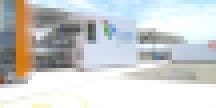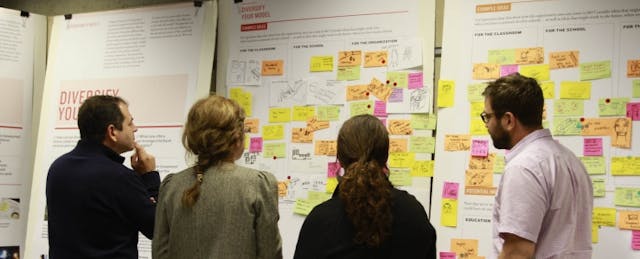What happens when a billionaire, an ex-engineer, and an IDEO design team get together to build a school system in Peru?
From the outside, it looks something like this:

Step inside, and you’ll see bright colors and flexible space. Students engage in constructivist group learning projects, and use Khan Academy and Pearson’s My English Lab, like many of counterparts at some of the U.S.’s top blended learning schools.
But Innova Schools aspires to be more than just an example of how first world ideas about blended learning and design thinking can be adapted in a developing country. It is trying to transform its country by closing the academic achievement gap, building Peru’s next generation of leaders, and making a profit while doing so.
In Steps the Billionaire
While Peru’s economy has been on the rise, its education system hasn’t. Over the past 10 years, Peru has experienced a boom in its middle class and in the demand for private schools. A quarter of the eight million students in Peru (and roughly half of all students in Lima) attend private schools--and for good reason: Only 17% of students attending public schools demonstrate proficiency on the country’s standardized test, administered once a year to second-graders. But private schools aren’t faring much better, with 21% proficient in math and 47% in literacy.
With the hope to provide something better, in 2005, Jorge Yzusqui Chessman, co-founder and Director of Innova Schools, quit his engineering job and started opening schools. He spent two years traveling around the world visiting schools and opened one of his own in North Lima. His school grew from 130 students to 500 in just a few years.
Four years later, Yzusqui Chessman was approached by a group from Intergroup Financial Services Corp. (Intercorp), one of Peru’s largest financial service companies. “They asked for a meeting. My first reaction was that they were coming to discuss some loans for my schools,” says Yzusqui Chessman. Little did he know this would be the beginning of a collaboration between him and Intercorp’s Chairman, billionaire Carlos Rodriguez-Pastor, to create the next generation of Peruvian schools.
Rodriguez-Pastor wanted to build a chain of low-cost private schools that could deliver high quality education and leadership development, specifically aimed at the lower-middle class. “He asked me how many schools I wanted to build. I said 15. He said 100. During our conversation, I realized he was the type of businessman who wanted to do something important in education in order to change our situation,” says Yzusqui Chessman.
Both realized that improving Peruvian education would take more than simply copying existing models. Despite the growing popularity of private schools, Peru ranked last out of 65 countries on the 2012 PISA exam. On the only national test administered in Peru, in second grade, 21% of private students scored proficient in math, and 47% in literacy.
To make an impact on education in Peru, Yzusqui Chessman’s and Rodriguez-Pastor knew they had to design something different. “Today, with communication, with technology, with the changes in the world we need to refresh the educational experience, says Yzusqui Chessman. “We needed to discover an educational system, not just a school. And we required a model that would be affordable, scalable, and excellent.” That’s when the seeds for Innova were planted.
Cue IDEO
Familiar with IDEO, the San Francisco-based design firm best known for designing the first laptop and Apple computer mouse, from his time at Tuck School of Business at Dartmouth College, Rodriguez-Pastor enlisted the firm to help design Innova.
IDEO works with clients in government, health care, business and technology, designing solutions that range from actual products, user experiences, or even processes such as Singapore's system for issuing work visas. The design firm began work in the education sector five years ago, helping schools redesign everything from curriculum to the cafeteria experience.
In 2011, Rodriguez-Pastor asked IDEO’s Head of Education Practice Sandy Speicher if her team could design a school system with the following requirements.
- Provide excellent academics;
- Be affordably priced (under $130 per month);
- Be profitable;
- Could grow up to 200 schools quickly in Peru and beyond.
“Carlos [Rodriguez-Pastor] approached us with the question and we were so excited about the authenticity he was bringing,” says Speicher. “It was so clear that he was fundamentally trying to improve his country.”
Shortly after, in the fall 2011, IDEO got to work. A core team of five design experts (in research, systems, business, communications, and space) traveled to Lima for one month of field studies, building relationships with the Innova school leadership team and talking to hundreds of potential students and families to find out what their lives were like and what they wanted to get out of a school.

From these interviews, they found a community that aspired for a better life, and that better life revolved around technology, the English language, and basic aesthetics. “The building had to be beautiful. We wanted people to feel proud to drop their kids off at school everyday,” says Speicher.
Once understanding these needs,the IDEO team turned to the issue of growth. They researched blended learning models across the world that could scale quickly. They looked at the KIPP network (in the U.S.) and Bridge International Academies (in Kenya), two models that have grown to hundreds of schools in less than ten years. The team also brought the Innova leaders to tour blended learning schools in the U.S. like Rocketship and Aspire, and introduced them to tools like Khan Academy, Teaching Channel, and TeachersPayTeachers.
After conducting research, the design process began.
IDEO knows as well as anyone that design is about working within limitations as much as creative freedom. All the glamor of modern buildings and technologies had to fit within human and space constraints. Finding qualified teachers would be a challenge. Land availability differed from site to site. And the financial plan had to make the school profitable while serving lower to middle class families.

“Any school system is going to have constraints to work within, and it’s a matter of finding where your levers are and where you can make a difference,” says Sally Madsen, Systems Designer at IDEO and the project lead for Innova.
By the winter of 2012, IDEO had a plan. With intense collaboration between school leaders at Innova and IDEO designers, a blended learning model was piloted to test out some of the initial ideas. Finally, in time for school in 2012 IDEO stepped back and watched the school system fly on its own.
A School System Is Born
As of spring 2014, Innova’s 23 schools serve over 13,500 students in grades K-11 across Peru. Most students come from lower-middle class families that make $1,200 per month. In half of Innova families both parents work in jobs like accountants, engineers, or small business owners. Families pay $130 per month to attend the school.
Student experience
Students spend their day rotating through two different configurations. For about five hours of the day, students are grouped in classes of 30. Then for the last three hours, the walls between classrooms are quickly broken down and students are combined into one class of 60. Here’s how it works:
Group time: 30 students collaborate with each other for peer-to-peer learning while one teacher acts solely as a guide. When students enter the class, the teacher proposes a challenge, which the students then tackle in small groups by sketching out solutions, using the internet or other handouts the teacher provides. Students end by presenting their solutions to the class.

Solo time: 60 students work independently through their content skills, using programs like Khan Academy, Time To Know, and Pearson’s My English Learner. While edtech products for Spanish speaking learners are not widely available, Innova has developed its own software, in partnership with Pontificia University Catolica a Peru, called Modus to teach science and literacy skills.
Teachers simply remind students of the skills they should be on pace to learn, where those resources can be accessed, and then give them autonomy to drive their own learning. While the network is piloting a 1:1 laptop program in two schools using Intel Classmate computers, most students currently leave the classroom and attend the media lab when their assignments call for computer-based learning.
Innovation Program: While the students use solo learning time to build independent thinking and management skills, they also use an Innovation Program to spark leadership qualities within their students. Once a year for two weeks, the school stops everything, and every kid from 3rd to 11th grade works on a specific social challenge. Then they display their solution to this social challenge in a science-fair type of display, allowing the community to contrast a 3rd grader’s approach to an 11th grader approach to the same challenge.

Teacher Experience
Although Innova demands over 725 teachers across the network, it has been a challenge for the school to recruit experienced teachers at the rate they need. To help prepare and arm inexperienced educators with resources to be more effective, IDEO designed and built Innova a tool called the "Teacher Resource Center," which is stocked with over 20,000 lessons.
Less experienced teachers are expected to rely on the Resource Center for 80% of their teaching resources, and develop the rest on their own. The more experience a teacher has, the more he or she is expected to contribute to it.
Space
“Usually in Peru the school is like a jail. But in our schools we have big transparency, many colors, and bandwidth throughout,” says Yzusqui Chessman. Each school is over 5,000 square meters and includes a nursery, classrooms, a teacher room, a library, computer center, cafeteria, green area, and sports center.
The schools are designed like a Lego. With modular structures (like fancy shipping containers) that can be put together in different configurations, Innova can change the school to fit the available land. If there's a lot of land, it can expand horizontally. If not, the classrooms can be stacked.

Growing, Getting Results And Looking Forward
Students at Innova have already surpassed the achievement of their peers in both government and private schools in Peru; 61% achieved proficiency in math, 86% in literacy. But tripling the scores of the government schools and doubling those of other private schools isn’t enough. School leaders have pledged to go from 61% proficiency in math (compared with the country’s 17%), to 75% in the next five years.
These results could help Innova with one of its biggest struggles: convincing parents that the model would work. “At the beginning it was very hard. Many parents asked about the methodology because it’s natural to want your daughter to study like you studied. Many parents were comparing the number of pages in our books, asking how learning would take place without big books,” says Yzusqui Chessman.
To address these concerns, Innova invited parents into the classroom to try the model out themselves. Now, every year 80% of new parents take the opportunity to spend a day in their student’s shoes, going through their own group learning and solo learning time.
Bringing parents in--literally--seems to be working. By 2020 Innova leaders plan to have a total of 70 schools open in Peru, serving a total of 60,000 students, with the possibility to expand into other countries in Latin America.
“In 2020 we won’t be satisfied being in the top of Peruvian schools. We want to be in the top of the world’s schools,” says Yzusqui Chessman.


